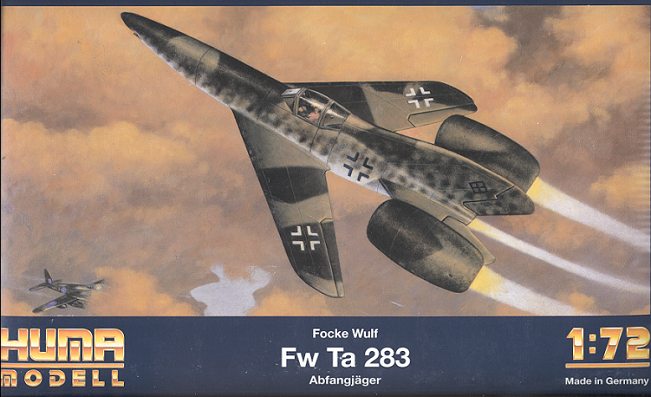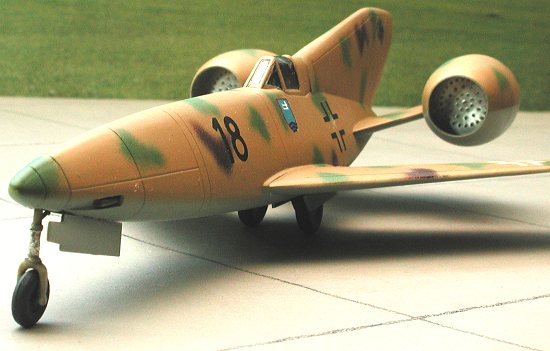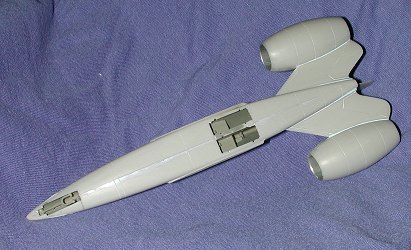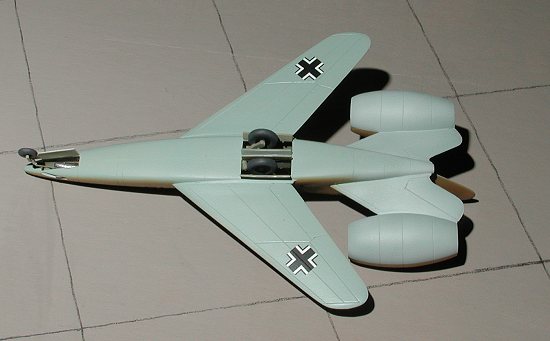
Huma 1/72 Focke Wulf Ta-283
|
KIT: |
Huma 1/72 Focke Wulf Ta-283 |
|
KIT # |
4003 |
|
PRICE: |
$16.98 |
|
DECALS: |
Generic |
|
REVIEW : |
|
|
NOTES: |

|
ALTERNATE HISTORY |

A long time ago, in an alternate universe far away, World War II didn't go exactly as it did here. In this universe, the Germans did not make a number of blunders. They actually defeated the RAF by destroying fighter bases and factories; they were not turned back from Moscow by the Russian winter of 1941/42; they managed to push the British Army back to the Suez Canal, thereby opening up the Near East and its oil fields.
Technologically, the turbine, rocket and ramjet engine were enthusiastically embraced by the Luftwaffe and so were developed much faster into viable weapons systems. Thanks to the abundant raw materials from a now defeated Russia combined with access to friendly nations in the Persian Gulf, Germany was able to produce all that it needed to keep the war machine going. No armies in the Soviet steppes meant that there were more troops and equipment available for continuing operations in Africa and against India as the Wehrmacht continued to move to consolidate positions and join up with their Japanese allies in the east.
Regarding the Western Allies, England was still there, but Hitler had decided to bypass the island instead of invading it. With the difficulty of getting supplies through to the UK, the British were unable to do much for the war effort from the home country. Fortunately, the Commonwealth continued the battle, joined by a United States that was strongly isolationist until being attacked by the Japanese. Getting war production underway was a slow process and with Axis allies and sympathetic nations all around the world, getting some raw materials was incredibly difficult.
The year in this alternate universe is 1946, German technology is far ahead of the Allies, Britain is cut off and the US is not doing as well as hoped and is basically holding its own. The Japanese are consolidating the Greater East Asia Co-Prosperity Sphere, having stopped at invading Australia or New Zealand and concentrating on slow but steady advances in China and India.
In the Caribbean, German forces have set up 'protective forces' on several islands that were part of the Dutch, French or Belgian 'empires'. Naval bases have been built on these islands in order to make it easier for U-boats to operate in the central and southern Atlantic and in the Caribbean/Gulf of Mexico areas. Each of these islands has an airstrip on which a squadron of aircraft have been placed for defensive purposes and to provide staging for long range bombing missions against Allied targets.
 It is here on Curacao near the northern coast of South America
that we find the hero of our story, Lt. Josef Scmidtlap, detachment commander.
He has been with 3./JG 57 for nearly a year now, having started his career as an
enlisted pilot in North Africa. He currently has 18 kills to his credit and has
been shot down twice, both times by the British. Fortunately, he was able to
escape his stricken aircraft. The second time he was captured by the Brits and
was a POW for a few months until the British 8th Army surrendered in Egypt. Then
it was on to other fronts until being posted here to Curacao.
It is here on Curacao near the northern coast of South America
that we find the hero of our story, Lt. Josef Scmidtlap, detachment commander.
He has been with 3./JG 57 for nearly a year now, having started his career as an
enlisted pilot in North Africa. He currently has 18 kills to his credit and has
been shot down twice, both times by the British. Fortunately, he was able to
escape his stricken aircraft. The second time he was captured by the Brits and
was a POW for a few months until the British 8th Army surrendered in Egypt. Then
it was on to other fronts until being posted here to Curacao.
Frankly, he could think of worse places to be (like Russia). Nice climate, if a little on the dry side and the base here at Su Casa was only a few kilometers from the main city of Willemstad. What was even better was that he could understand the natives, Dutch not being that much different from German. What he didn't like about this posting was the aircraft he was flying. Frankly, he didn't trust it that much.
The Focke-Wulf Ta-283 was a combination interceptor. By that, it had two different types of engine. One was a 'standard' liquid fuel rocket as was used in the earlier Me-163 and 263. The other were two huge ramjets. It was up to the rocket engine to get the 283 to speed where the ramjets were able to operate. Once those were running, the speed was incredible, though the flight duration was short. What he didn't like were the fuels. They were caustic to an extreme and would eat bare skin. This means he had to wear a rubberized flight suit that was impervious to the fuels. It was also impervious to comfort as the material didn't breathe. Two pilots were on constant alert status which meant that for four hours, one had wear the damn things in case enemies came to attack the U-boat base on the other side of Willemstad at Nieuwpoort. Today was Josef's turn on alert.
As he was laying on his beach chair under an umbrella sipping on a cold drink (non-alcoholic, of course. This is duty), Josef was waiting for a): his shift to be over, or b): something to happen. He got b). Suddenly the klaxon sounds and the field erupts into motion. Josef grabs his helmet and with help from his awaiting crew chief, gets it sealed on and the pressure checked.
He then hops into his desert camouflaged 283, Black 18, and plugs himself into the aircraft as the auxiliary power cart, which has been keeping the batteries charged, is pulled away. Two interesting things about these aircraft. First of all, every hardstand is situated so that there is no taxiing, With nothing but rockets and ramjets, there is no way to go slowly. Once the rocket is lit it is a very short amount of time before it is airborne. In fact, getting the gear up quickly enough to prevent damage is always a challenge. Additional aircraft are already hooked up to tow tractors that will bring them to the end of the runway. Taxiing these beasts is not recommended thanks to the incredibly narrow track. Even the 109s that were flown during training had a wider undercarriage.
Secondly, one doesn't have to let the engines warm up. All you have to do is hit the 'go' button and a valve opens up allowing the C-stoff and T-stoff to come into contact with each other. Instant ignition. With that thought in his mind, Lt Schmidtlap presses the ignition button and is pressed back in his seat as the rocket engine fires and he speeds across the field. In seconds the plane is airborne and the wheels retracted. Josef then pulls back on the stick and the aircraft shoots up into the stratosphere. When 500 kph is reached, the ramjets automatically start and the rocket shuts down. Fortunately the rocket is a new type with throttle controls so can be operated in spurts for landing.
On his way up he is given bearing information by the controllers. Apparently there is a lone aircraft flying at high altitude headed this way from the west. 'Hmm, Yank photo reconnaissance aircraft trying to get some pictures, eh? Well, I'll see what I can do to prevent that.' This was normally the reason for these alert missions. With bases in Panama, it was not unusual for the Americans to send planes based there in this direction from time to time to see what had changed since the last time. Knocking one down was very difficult.
Climbing to around 17,000 meters, Lt Schmidtlap scanned the seas below for the intruder. One of the real benefits of the 283 was that it had a very high ceiling, much higher than that of most intruders. Not only that, but it was able to reach it quickly. Downside is that fuel is quite limited so there isn't much time to find the intruder. The high speed of the 283 also means that it can be out-maneuvered by nearly everything else in the skies, especially the American recce planes as they tend to be prop driven.
 Calling ground radar for more bearing info, he was vectored
toward the invader. Nearing the location he was able to barely make out a glossy
blue form a few thousand meters below. It was a sleek twin-engined, twin boomed
aircraft moving quite fast. Remembering from the silhouettes, he determined that
this was the relatively new Hughes F-11, a rather large aircraft that operated
at around 13,000 meters. Already it was nearing the island and turning to make
its run.
Calling ground radar for more bearing info, he was vectored
toward the invader. Nearing the location he was able to barely make out a glossy
blue form a few thousand meters below. It was a sleek twin-engined, twin boomed
aircraft moving quite fast. Remembering from the silhouettes, he determined that
this was the relatively new Hughes F-11, a rather large aircraft that operated
at around 13,000 meters. Already it was nearing the island and turning to make
its run.
Lt. Schmidtlap nosed over his 283 and dived on his foe. He swooped below and behind the speeding plane and pulled the nose up to start firing at the underside. As soon as his 30mm cannon started firing, the F-11 pilot must have seen the tracers as he started turning towards the oncoming 283. Those big wings on the F-11 were able to perform maneuvers that would only cause the 283 to stall in the thin air. Several more attempts were made to knock down the American, but each time that Josef got a bead and started to fire, the recce pilot would start maneuvering and evade the fire.
This was getting frustrating; what's more, fuel was becoming critical. He had enough fuel for one more pass. The fight had brought them over Curacao so Josef called for reinforcements. His radio call went unanswered. Damn! it seems that the transmitter has gone tits up during the fight. Getting aligned for his final pass, he tried this one from above and a bit to the rear. As he got in range, he started firing. The American started turning to evade. This time, instead of continuing on, the German pilot pulled the nose up and in the direction of the F-11.
The 283 started to come around, juddering as it did so. The blue recce bird was coming into his sights! He had another chance! Just at that moment, the 283 gave a huge twitch and started to spin upside down toward the island below. All attempts at getting the aircraft straightened out were futile as it kept spinning and heading for ground. As he passed through 4,000 meters, he thought it was about time to get out while the getting was good. Unhooking all the restraints, he tried to jettison the canopy, but air pressure kept it in place. Pushing with all his might he managed to force off the canopy and fell into the windstream, crashing against the tail of his plane on his way out. A searing pain hit him as he started to black out. With the last of his consciousness he pulled on the rip cord and he thinks he heard the chute open up.
Coming to, he was still several hundred meters from the ground, but it was coming up fast. Steering toward an open spot he hit the ground with a thud and blacked out again. Hours later he awoke in a great deal of pain. It seems that he broke something when he hit the plane. Nothing really to do but to take some pain killers and await rescue as he sure can't go far as he is. He pulled out a flare and waited.
After what seemed like hours of waiting, he heard the wop, wop, wop of propellers from a rescue aircraft. He sets off his flare and is rewarded by the sight of the rescue chopper headed in his direction. As ugly as he always thought the Fa-223s to be, it was currently one of the most beautiful sights he had seen. After being helped into the rescue basket by the rescue technician, he was hoisted in to the helo and on the way back to base and the hospital. The American F-11? Well, he not only successfully completed his mission but evaded the second 283 sent up to try to knock him down. Hmmm. There are times when the newest and the fastest are not always what is the best. As he drifted off on the return flight, he made a mental note to ask for more conventional fighters to combat these intruders.
|
THE KIT |
Please go here to read about what is in the box.
|
CONSTRUCTION |
Lots of parts this kit doesn't have, so construction is not going to be a long and drawn out affair. The first thing I did was to look over the instructions to see what parts could be built up as subassemblies. Basically, it was the cockpit and the engines. The engines consist of two nacelle halves and a center part, which is supposed to be the diffuser for the ram jet. Fit was fairly good, though there is need for filler where the upper nacelle half meets the pylon. The interior is basically a floor, seat, stick and rudder pedals. The rudder pedals and stick are on the sprue of finely molded parts. Being made of plastic doesn't cure the 'zing' factor small bits have as I spent a few quality minutes searching through my rug for one of them. To be hones, the pilot needs to have 8 foot long legs to read these pedals as they are way too far removed from the seat. That is a kind way of saying that there is LOTS of room for detailing the interior.
 You are supposed to glue the completed main landing gear to the
bottom of the interior, so the underside of the cockpit is also the upper side
of the main wheel well. There is a partition that sticks up into the bottom of
the cockpit floor. The slot that is left needs to be filled and sanded smooth
before going too far with cockpit assembly. I left off the landing gear as it
would just interfere with painting later on. I can only hope that I didn't screw
up too bad regarding this! Once done, the cockpit was painted RLM 66 and
the underside RLM 02. The instrument panel was painted RLM 66 and the decal
placed on it.
You are supposed to glue the completed main landing gear to the
bottom of the interior, so the underside of the cockpit is also the upper side
of the main wheel well. There is a partition that sticks up into the bottom of
the cockpit floor. The slot that is left needs to be filled and sanded smooth
before going too far with cockpit assembly. I left off the landing gear as it
would just interfere with painting later on. I can only hope that I didn't screw
up too bad regarding this! Once done, the cockpit was painted RLM 66 and
the underside RLM 02. The instrument panel was painted RLM 66 and the decal
placed on it.
Next step is the fuselage. This was painted the appropriate RLM 66 or 02 colors as needed. There is a small bulkhead that was fit into the nose section. The bulkhead is also an attachment point for part of the nose gear. Behind that was glued a large fishing weight to compensate for the weight of the aft mounted engines. Then the interior and instrument panel were glued in place. Once that was dry, the fuselage halves were glued together. At this time I also installed the nose gear, trapping it between the two mounting slots. I made sure no glue got on this part. When the fuselage was dry, the nose gear was folded into the well and the fuselage was filled and sanded as needed, and quite a bit was needed.
It was then time to fit the engine pods. Huma has provided positive locater tabs on the wings and engine pods that interlock and help with alignment. A nice touch, though they will have to be trimmed slightly to fit properly. Once the engines were installed, there was need for filling and sanding the joins there as well. Not the easiest place to sand. In some cases, Mr.Surfacer 500 was sufficient to do the job. If you can find this material, I highly recommend it. Basically it is thin filler. The #1000 can be sprayed.
 Fuselage done sans wings |
 Looks like something from Star Wars Episode I |
Once the fuselage was done, the wings were fit. The fit was fairly good on the top, but there were gaps on the underside that needed attention. Thankfully the alignment tabs worked well. I did not glue them both at the same time, but did the right wing and when dry, the left. I feel this helped overall alignment of the wings to have the same dihedral. The next step was to glue on the canopy. I notice that my cockpit section had not dried perfectly level so had to carve a bit in order to get the canopy to fit properly. The canopy was then masked, various holes filled with tissue and it was off to the paint shop.
|
PAINT |
Since the story is about a desert camouflaged 283, I thought it
best to paint the model like that. First thing was to paint the underside in RLM
76 using my depleting stash of Aeromaster enamels. The upper surfaces were then
painted with Xtracolor RLM 78 desert tan. Must have been lucky in mixing it as
it dried rock hard in just a few hours. Nevertheless, I let it cure overnight.
It looked too bare like that so I decided to add some additional upper surface
colors. Both of these are from the Aeromaster range. First was RLM 83 bright
green, and that was applied in splotches. Next, I needed a brown. I looked at
the myriad of colors available and decided to use Japanese 'Prop Color' for this
part of the scheme. It was applied in even more sparse patches than the green.
Overall, the result is quite pleasing. It was then back to the bench for more
construction prior to applying the decals.
|
CONSTRUCTION CONTINUES |
The
main gear have two thin and fragile little actuating struts to glue on. These
did not fit very well as the attachments are rather vague. Needless to say, they
were finally attached and look OK. Then the gear were glued into the wells. I
had to trim the gear attachment lugs a tiny bit to get them to fit. Man, this
thing would have had a narrow track. Obviously it was not meant to take any kind
of corners at speeds faster than a man can walk or it would have tipped over
quite easily. Once dry, the inner gear doors were attached. These
also needed a bit of trimming to fit well. The main wheels were then glued onto
the gear struts. It was then that I noticed that the gear had not dried
perfectly perpendicular with the forward gear wall. The wheels are therefore, a
bit cocked and have some toe-out. Next step was applying the outer gear doors
and the nose gear door. The next step was to attach the landing gear. First, the nose
gear. The tissue was removed from the well and the gear pulled out of the well.
A Bare Metal Foil oleo was applied. The very thin and fragile-looking retraction
strut was then glued in place, having been previously painted. It was after this
had dried that I managed to break the fork from the nose gear. Oh well, another
in a never-ending series of screw-ups when it comes to modeling. It was
reattached using superglue and the nose wheel plugged in.
The next step was to attach the landing gear. First, the nose
gear. The tissue was removed from the well and the gear pulled out of the well.
A Bare Metal Foil oleo was applied. The very thin and fragile-looking retraction
strut was then glued in place, having been previously painted. It was after this
had dried that I managed to break the fork from the nose gear. Oh well, another
in a never-ending series of screw-ups when it comes to modeling. It was
reattached using superglue and the nose wheel plugged in.
|
DECALS & FINAL TOUCHES |
Time to apply some decals. The biggest fun part of these kits is to find something in the way of unit badges to stick on it. There are a number of sources for these things, and if you save all your kit decal bits, you'll have no trouble finding anything appropriate. I used the kit decals for all the national insignia and an Xtradecal sheet for the swastika. The unit badge was gleaned from an old ESCI Ju-52 sheet and the numbers from an equally old Heller He-112 sheet. A bit of Sovaset cured any hesitancy on the decal's part to snuggle into panel lines. A bit of touchup with the paint, a coat of clear semi-matte, the removal of the tape from the canopy and the kit was done!

|
CONCLUSIONS |
I cannot say enough about how much I enjoy building these Huma kits. They are not top of the line in engineering as are the most current Japanese kits, but they are also far above 99% of all short run kits. They are not full of zillions of bits and can be built by most modelers in a relatively short time. Best of all, you can paint them any way you want and not have to worry about 'experts' prejudging your model. Highly recommended.
February 2001
Copyright ModelingMadness.com. All rights reserved.
Review kit courtesy of me and my wallet!
If you would like your product reviewed fairly and fairly quickly, pleasecontact the editor or see other details in the Note to Contributors.